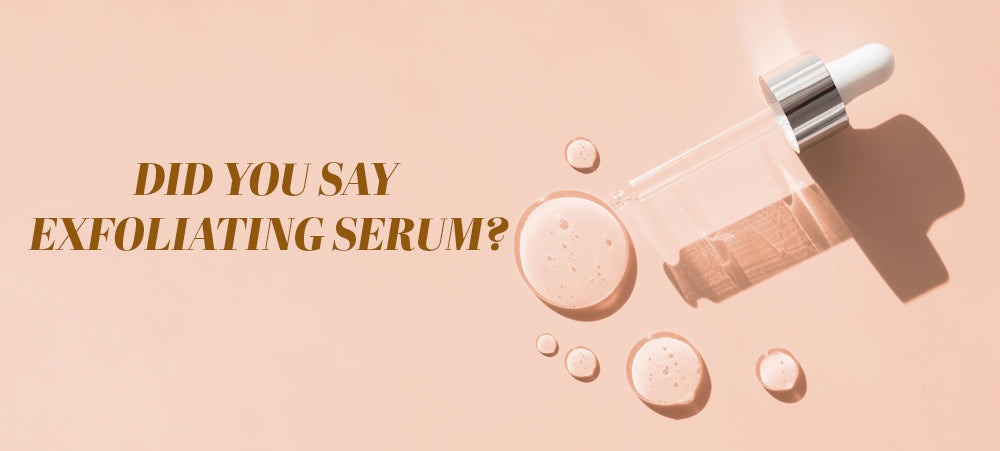THE BLOG

EXFOLIATING WITH SERUMS
Exfoliating serums can help you achieve your skin care goals, including improving skin texture, fading hyperpigmentation, eliminating acne, or brightening up your complexion.
Unlike scrubs, which contain hard, rough particles to shed away dead skin, serums rely on chemical exfoliants to gently dissolve dead skin cells on the skin's surface to reveal fresher, brighter, clearer skin.
All skin types can benefit from regular exfoliation with serums and, since most are blended with hydrating or soothing ingredients, it makes them particularly helpful for dry and sensitive skin.
Here is our guide on how to get started with exfoliating serums:
WHAT ARE EXFOLIATING SERUMS?
Exfoliating serums often use acids such as alpha hydroxy acids (AHAs) or beta hydroxy acids (BHAs) to infiltrate the layers of the skin, break down dead cells, and promote clear, glowing skin.
The most common AHAs are lactic acid and glycolic acid. These dissolve cells and help surface brighter and healthier skin cells. The most common BHA is salicylic acid. Unlike AHAs, BHAs are oil soluble and can infiltrate the skin's surface. They are great for cleaning pores, dissolving dead skin, and relaxing breakout-related redness.
If a serum contains one or more of the active ingredients noted above, it is likely a chemical exfoliant.
IS CHEMICAL EXFOLIATION REALLY BETTER THAN PHYSICAL EXFOLIATION?
Most dermatologists recommend acids (often referred to as “chemical exfoliation”) in favour of face scrubs (often referred to as “physical exfoliation”) to remove oil and dead cell buildup without irritating the skin.
Physical exfoliation used to be much more widespread when it came to polishing the skin. The trouble with many physical exfoliating products is that they are way too harsh on the skin. Some contain large particles like apricot shells, which can cause tears and damage to the skin.
HOW EXFOLIATING SERUMS CAN BE USED IN YOUR SKIN CARE ROUTINE
The following routine will help you get the most out of your exfoliating serum:
1. Cleanse Your Skin
Start by cleansing your skin with a gentle face wash (like our Refreshing Jojoba Cleansing Oil or Hydrating Cleanser with Hyaluronic Acid). It is always important to start with a clean base before applying serums. This way, they can properly absorb into the skin. If you do not cleanse before using skin care products, they may not be able to effectively infiltrate the skin. By starting with cleansing, you can boost the benefits of exfoliating.
2. Do Not Exfoliate Dry Skin
While your skin is still a little damp, apply a thin layer of our exfoliating serum (Radiant Exfoliating Serum with Retinol & Lactic Acid or No Texture Exfoliating Serum with Glycolic Acid) to your face and neck, and massage it in using circular motions. Avoid applying too much product as this may irritate the skin and lead to issues like redness and peeling. Let it absorb before continuing with the next step.
3. Moisturize Your Skin
Next, use a nourishing face cream (like our Radiant Glow Crème or our Rejuvenating Serum with Vitamin C) to hydrate and brighten the skin and ward off dryness. If you have got dry or aging skin, it is best to use a cream as this will seal in the products as well as promote lasting hydration.
If you have oily or acne-prone skin, stick to using lighter creams or hydrating serums to keep your skin moisturized without clogging your pores and triggering further breakouts.
4. Do Not Forget to Apply SPF!
Sunscreen is always necessary. Even more so if you are using exfoliating serums in the morning or afternoon. Whether it is bright and sunny or dark and cloudy outside, UV rays are always present, which leaves your skin exposed to sun damage and premature aging.
It is very important to invest in a superior SPF to always protect your skin.
5. Exfoliate Two to Three Times a Week
It is good to avoid exfoliating daily, since this can weaken the skin barrier and cause irritation. If you have normal, oily, acne-prone, or aging skin, exfoliate two to three times a week for best results. However, those with sensitive skin should limit exfoliation to once a week. Exfoliating more often than that can lead to undesirable results, such as redness, itching, and flaking.
Most skin types can benefit from regular exfoliation. Preferably, you should be exfoliating at least once a week to keep skin clear, smooth, and glossy.
We hope you found our guide helpful!